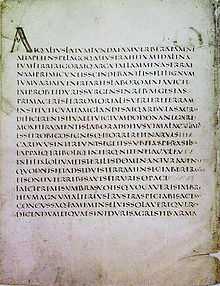Scriptio continua

Scriptio continua (Latin for "continuous script"), also known as scriptura continua or scripta continua, is a style of writing without spaces or other marks between the words or sentences.
In the West, the oldest Greek and Latin inscriptions use word dividers; however, Classical Greek and late Classical Latin both employed scriptio continua as the norm.[1][2] Before the advent of the codex (book), Latin and Greek script was written on scrolls. The reader would typically already have memorized the text through an instructor, had memorized where the breaks were, and the reader often read aloud, usually to an audience in a kind of reading performance, using the text as a cue sheet. Organizing the text to make it more rapidly ingested (through punctuation) was not needed and eventually the current system of rapid silent reading for information replaced the older slower performance declaimed aloud for dramatic effect.[3] By around AD 1000, European texts were written with spaces between words[4]
Scriptio continua is still in use in Thai, other Southeast Asian abugidas (Burmese, Khmer, Javanese, Balinese, Sundanese script), Lao, and in languages that use Chinese characters (Chinese and Japanese). Modern vernacular Chinese differs from ancient scriptio continua in that it does at least use punctuation, although this was borrowed from the West only about a century ago. Before this, the only forms of punctuation found in Chinese writings were punctuations to denote quotes, proper nouns, and emphasis. Modern Tibetic languages also employ a sort of scriptio continua; although they punctuate syllables, they do not use spacing between units of meaning.
Examples
Latin text
Latin text in scriptio continua with typical capital letters, taken from Cicero's De finibus bonorum et malorum:
- NEQVEPORROQVISQVAMESTQVIDOLOREMIPSVMQVIADOLORSITAMETCONSECTETVRADIPISCIVELIT
Which in modern punctuation is:
- Neque porro quisquam est qui dolorem ipsum quia dolor sit amet, consectetur, adipisci velit…
- "Nobody likes pain for its own sake, or looks for it and wants to have it, just because it is pain…"
Modern English
A form of scriptio continua has become common in internet e-mail addresses and domain names where, because the "space" character is invalid, the address for a website for "Example Fake Website" is written as examplefakewebsite.com – without spaces between the separate words.
Spring and Fall (1880) by Gerard Manley Hopkins rendered in scriptio continua (20 characters per line):
MARGARETAREYOUGRIEVI NGOVERGOLDENGROVEUNL EAVINGLEAVESLIKETHET HINGSOFMANYOUWITHYOU RFRESHTHOUGHTSCAREFO RCANYOUAHASTHEHEARTG ROWSOLDERITWILLCOMET OSUCHSIGHTSCOLDERBYA NDBYNORSPAREASIGHTHO UGHWORLDSOFWANWOODLE AFMEALLIEANDYETYOUWI LLWEEPANDKNOWWHYNOWN OMATTERCHILDTHENAMES ORROWSSPRINGSARETHES AMENORMOUTHHADNONORM INDEXPRESSEDWHATHEAR THEARDOFGHOSTGUESSED ITISTHEBLIGHTMANWASB ORNFORITISMARGARETY OUMOURNFOR
Spring and Fall (1880) by Gerard Manley Hopkins rendered in normal punctuation:
- Margaret, are you grieving
- Over Goldengrove unleaving?
- Leaves, like the things of man, you
- With your fresh thoughts care for, can you?
- Ah! as the heart grows older
- It will come to such sights colder
- By and by, nor spare a sigh
- Though worlds of wanwood leafmeal lie;
- And yet you will weep and know why.
- Now no matter, child, the name:
- Sorrow's springs are the same.
- Nor mouth had, no nor mind, expressed
- What heart heard of, ghost guessed:
- It is the blight man was born for,
- It is Margaret you mourn for.
Chinese language
Here is an example of a normal Chinese sentence, then what it would look like with spaces between words, then a pinyin transcription (in which words are normally divided), and finally an English translation:
- 北京在中国北方;广州在中国南方。
- 北京 在 中国 北方; 广州 在 中国 南方。
- Běijīng zài Zhōngguó běifāng; Guǎngzhōu zài Zhōngguó nánfāng.
- Beijing is in Northern China; Guangzhou is in Southern China.
Javanese script
An example of the first line of the declaration of human right in Javanese script, and when they are divided (in some modern writings) by spaces and dash sign, which looks different: (if you can't see the script, you can see the sample image here)
- ꧋ꦱꦧꦼꦤ꧀ꦲꦸꦮꦺꦴꦁꦏꦭꦲꦶꦂꦫꦏꦺꦏꦤ꧀ꦛꦶꦩꦂꦢꦶꦏꦭꦤ꧀ꦢꦂꦧꦺꦩꦂꦠꦧꦠ꧀ꦭꦤ꧀ꦲꦏ꧀ꦲꦏ꧀ꦏꦁꦥꦝ꧉ – saběnuwongkalairrakekanthimardikalandarbemartabatlanakakkangpadha. (transliterated without space, Javanese script doesn't have majuscule/minuscule differentiation).
- ꧋ꦱꦧꦼꦤ꧀ ꦲꦸꦮꦺꦴꦁ ꦏꦭꦲꦶꦂꦫꦏꦺ ꦏꦤ꧀ꦛꦶ ꦩꦂꦢꦶꦏ ꦭꦤ꧀ ꦢꦂꦧꦺ ꦩꦂꦠꦧꦠ꧀ ꦭꦤ꧀ ꦲꦏ꧀-ꦲꦏ꧀ ꦏꦁ ꦥꦝ꧉ – saběn uwong kalair(r)ake kanthi mardika lan darbe martabat lan (h)ak(-h)ak kang padha.
Because of the absence of space, in modern writing (and in computer), the line-break have to be inserted manually, otherwise a long sentence will not break into new lines. Some computer input methods have put zero-width space (ZWS) instead for word break, which would then break the long sentences into multiple lanes, but the drawback of that method is it will not render the writing "correct".
- ꧋ꦱꦧꦼꦤ꧀ꦲꦸꦮꦺꦴꦁꦏꦭꦲꦶꦂꦫꦏꦺꦏꦤ꧀ꦛꦶꦩꦂꦢꦶꦏꦭꦤ꧀ꦢꦂꦧꦺꦩꦂꦠꦧꦠ꧀ꦭꦤ꧀ꦲꦏ꧀ꦲꦏ꧀ꦏꦁꦥꦝ꧉ ("incorrect" words include the first two words, which in joined form would looks like ꦱꦧꦼꦤ꧀ꦲꦸꦮꦺꦴꦁ)
See also
- Interpunct, for the word dividers used before the advent of spacing
- Boustrophedon
- Codex Sinaiticus
References
- ↑ E. Otha Wingo. (1972). Latin punctuation in the classical age. The Hague: Mouton.
- ↑ Brent Harmon Vine (1993). Studies in archaic Latin inscriptions. Innsbruck: Institut für Sprachwissenschaft der Universität Innsbruck.
- ↑ Richard A. Lanham (2006). The Economics of Attention. ISBN 0-226-46882-8. page 113-115
- ↑ Saenger, Paul (1997) Space between words: the origins of silent reading, Stanford University Press, Stanford, California.